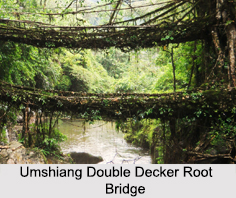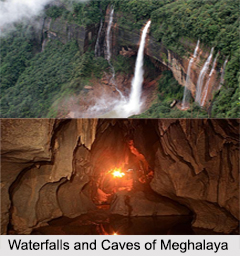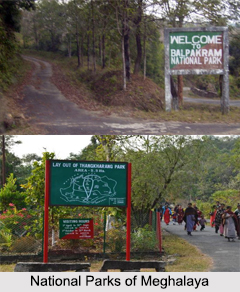 With lush green landscapes, picturesque surroundings, white clouds and mists, the north eastern state of Meghalaya has been rightly called the "abode of clouds". This Indian state is an incredibly beautiful tourist destination and over the years tourism in Meghalaya has proliferated immensely.
With lush green landscapes, picturesque surroundings, white clouds and mists, the north eastern state of Meghalaya has been rightly called the "abode of clouds". This Indian state is an incredibly beautiful tourist destination and over the years tourism in Meghalaya has proliferated immensely.
There are several national parks, wildlife sanctuaries and majestic waterfalls which enhance the beauty of the state. Meghalaya also offers adventure tourism in the form of mountaineering, rock climbing, trekking and hiking, caving and water sports. Discussed elaborately below are the prime activities and places that facilitate tourism in Meghalaya:
Cherrapunji: One of the wettest places on Earth, the town of Cherrapunji stands at an elevation of 1,484 m above the misty valleys and foaming rivers, sheltered in swirling clouds and perched on an escarpment. Most of the tourist attractions of Meghalaya are located here in this town, starting with waterfalls to caves and even national parks.
Some of the famous tourist spots in Cherrapunji are the Mawsmai Cave, Krem Mawmluh Cave, Nohkalikai Falls, double decker Living Root Bridge, Seven Sisters Falls, Dainthlen Falls, Krem Phyllut, Thangkharang Park, Eco Park, Kynrem Falls, Motrop or Khoh Ramhah, Dawki, Mawlynnong, Mawsmai Falls, Nongsawlia, Mawsynram, Khasi Monoliths and the Nokrek National Park.
Living Root Bridges of Meghalaya: Mostly common in the state of Meghalaya, the Living Root Bridges are handmade from the aerial roots of rubber fig trees and has a life span of up to 500 years. The Umshiang double decker Root Bridge of the Nongriat village is the most popular and is traversed by tourists frequently. There are three known examples of double bridges with two parallel or nearly parallel spans. Out of these, two are in the West Jaintia Hills near the villages of Padu and Nongbareh, and one is in Burma Village, in the East Khasi Hills.
 Waterfalls of Meghalaya: The waterfalls of Meghalaya cascade down a great height into the steep mountains and are major tourist attractions. Nohkalikai, one of the tallest waterfalls in India is a major attraction in the state. Some of the other popular waterfalls in Meghalaya are the Elephant Falls, Shadthum Falls, Weinia Falls, Bishop Falls, Langshiang Falls and Sweet Falls.
Waterfalls of Meghalaya: The waterfalls of Meghalaya cascade down a great height into the steep mountains and are major tourist attractions. Nohkalikai, one of the tallest waterfalls in India is a major attraction in the state. Some of the other popular waterfalls in Meghalaya are the Elephant Falls, Shadthum Falls, Weinia Falls, Bishop Falls, Langshiang Falls and Sweet Falls.
Caves of Meghalaya: The state of Meghalaya is home to few of the longest cave passages in the country. It is seen that a large number of caves in Meghalaya are located in the low mountainous regions of the Garo, Khasi and Jaintia Hills districts. Studies have revealed that out of the ten longest and deepest caves in India, the first nine are in Meghalaya. The Krem Liat Prah is the longest natural cave and Synrang Pamiang is the deepest.
 National Parks of Meghalaya: There are many parks and wildlife sanctuaries in Meghalaya, some of them are Balpakram National Park, Nokrek National Park as well as the Nokrek Biosphere Elephant Reserve, Siju Bird Sanctuary, Baghmara Pitcher Plant Sanctuary and Nongkhyllem Sanctuary.
National Parks of Meghalaya: There are many parks and wildlife sanctuaries in Meghalaya, some of them are Balpakram National Park, Nokrek National Park as well as the Nokrek Biosphere Elephant Reserve, Siju Bird Sanctuary, Baghmara Pitcher Plant Sanctuary and Nongkhyllem Sanctuary.
The Balpakram National Park is situated to the extreme south Garo hills of Meghalaya. Apart from elephants and tigers, the great hornbill, wildcats, wild buffalo and leopards are also found here. Hillock gibbons, the only ape species found in India, are found in this National park. The Siju bird sanctuary is one of the finest bird sanctuaries in the north east region. This sanctuary is a bird watcher`s delight. It is a home to many unique varieties of birds as well as those which are on the verge of extinction.
Lakes of Meghalaya: Meghalaya is known for its many natural and manmade lakes. The Umiam Lake in the state is a beautiful lake which is surrounded by mountains. This makes for an ideal picnic spot for the tourists. The Ward Lake in Shillong is an artificial lake and is quite popular for boating and water sport activities.
Hill stations in Meghalaya
Meghalaya boasts a trio of captivating hill stations, namely Jaintia Hills, Khasi Hills, and Garo Hills. Each region offers its own unique blend of natural beauty, cultural heritage, and serene landscapes.
Jaintia Hills: Situated in the eastern sector of Meghalaya, the Jaintia Hills exude an air of historical significance as they find mention in the annals of the Ahom dynasty and other neighboring cultures. This region is a canvas of remarkable sights, from monoliths that stand as silent sentinels to the allure of boats gliding across the crystalline waters. Hidden within its secretive forests, one can discover the mesmerizing spectacle of waterfalls cascading over time-worn rocks. Jaintia Hills showcases quintessential Meghalayan vistas with its undulating routes meandering through highland meadows and steep tropical terrains. Notable destinations within the Jaintia Hills include Dawki, renowned for its pristine beauty, Nartiang monoliths that reflect ancient history, the captivating Krangshuri waterfall, Kudengrim, and the Nartiang Durga temple.
Khasi Hills: Home to Meghalaya`s loftiest peaks, the Khasi Hills are characterized by their dramatic landscapes and hold the distinction of housing some of the world`s rainiest regions. This southern boundary of Meghalaya boasts renowned spots like Sohra and Mawsynram, drawing visitors for generations to witness the spectacle of monsoons in full force. Amidst this natural magnificence lies Shillong, a town that elegantly juxtaposes small-town charm with contemporary urban vibrancy. Key attractions across the Khasi Hills encompass Sohra, famous for its natural allure, the marvelous Kyllang rock, the quaint village of Mawlynnong, the iconic Nongriat double-decker root bridge, the serene Mawphanlur, the picturesque Umiam Lake, the tranquil Pynursla, and numerous other captivating locales.
Situated in the Khasi Hills, Shillong, the capital city of Meghalaya is a prime tourist spot for recreation. Then there is Jowai, the second biggest town in the state is the gateway to Nartiang, a delightful village further north that has a bizarre collection of druid stones. Tourism in Meghalaya is a flourishing business due to its serene locales and scenery.
Garo Hills: The western expanse of Meghalaya, the Garo Hills, is aptly described as wild and verdant. This region serves as a haven for a diverse array of wildlife, ranging from majestic elephant herds to the elusive Hoolock gibbons and enigmatic predators. For enthusiasts of angling, the meandering river courses offer ample opportunities for exploration. Beyond its natural splendor, the Garo Hills are renowned for their unique cultural traditions and distinctive cuisine. Notable destinations in the Garo Hills include the intriguing Siju Cave, the prominent Tura Peak, the picturesque Rongbangdare Waterfalls, the serene Daribokgre, the Memo Lake, and many other captivating sites.
Visiting Information on Meghalaya
The railway station at Guwahati is the nearest station to the state at a distance of about 189 km and the Lokpriya Gopinath Bordoloi International Airport is the closest at about 157 km from Meghalaya.



















